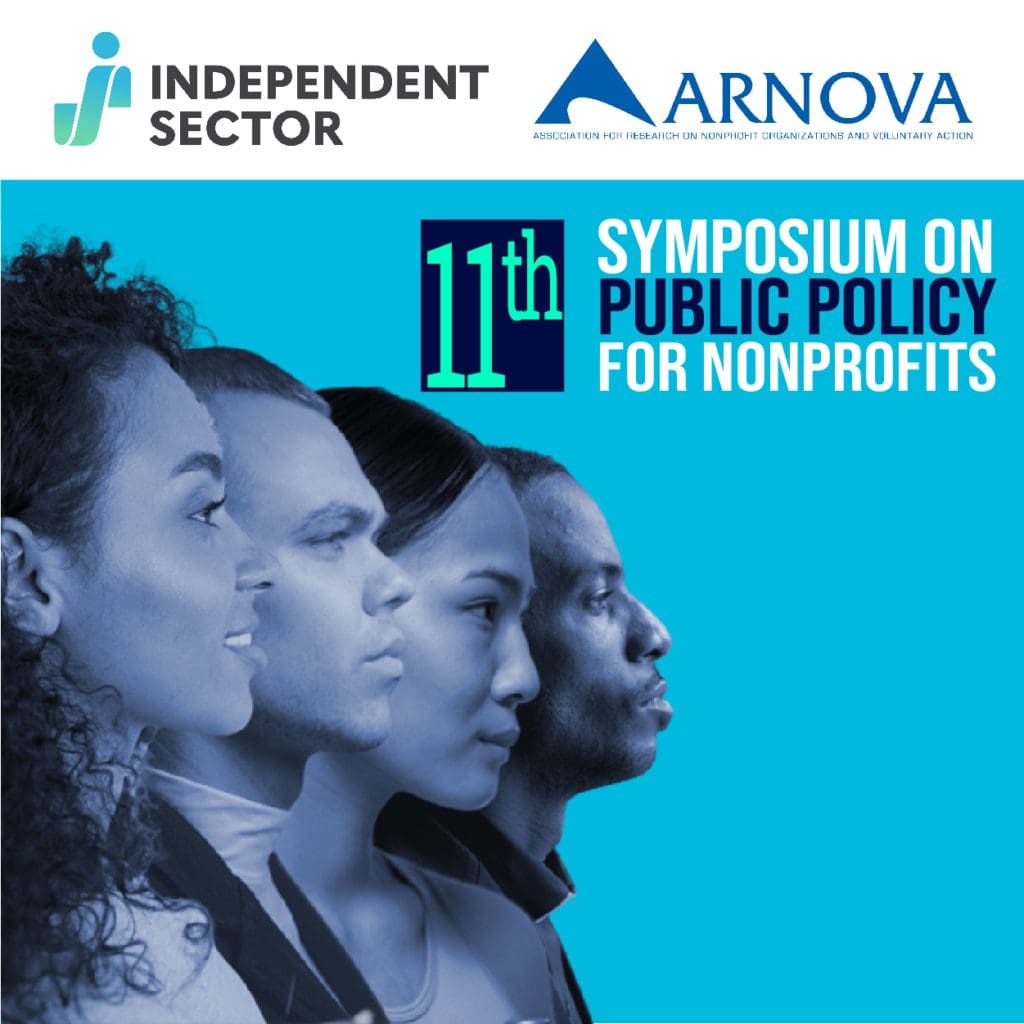The nonprofit sector and our employees have faced significant labor force challenges in the past few years, including recruitment, retention, and burnout. Many of these workforce challenges could be improved through public policy solutions such as reforms to the public service loan forgiveness program, access to affordable childcare, and civil rights protections for nonprofit employees. However, despite the impressive size and impact of the nonprofit workforce, we are most often invisible to policymakers without significant advocacy by the sector.
In order to better understand our own human capital needs and trends, Independent Sector, the Association for Research on Nonprofit Organizations and Voluntary Action (ARNOVA), and Nonprofit Policy Forum convened the 11th annual Nonprofit Public Policy Symposium on October 14, 2022. The symposium brought together nonprofit practitioners, academics, and a record number of attendees to discuss the latest research and trends in the field.
Research Findings and Trends
Overall, it was confirmed that nonprofit workers have a shared sense of pride in their work, but also shared grievances and the desire for systemic change. The following research findings and sector trends were identified:
Nonprofit business models built on low-pay, long hours, and strict education requirements. Younger workers are pushing back against these models by leading unionization efforts or leaving the sector. Research* presented at the symposium showed that meaningful work is not enough to retain employees; pay, flexibility, empowerment in their roles, opportunities for advancement, and work-life balance are also important. Research also showed that advanced degree and ongoing licensure requirements may not translate into higher quality services and place an additional financial burden on workers. The sector risks being viewed as a “training ground,” rather than a career path.
Pressure from funders informs or dictates workforce decisions. Pervasive expectations of low-overhead costs as a proxy for nonprofit effectiveness and detailed reporting requirements that differ from one funder to another influence nonprofit workforce and programming decisions. Low-overhead impacts wages and can lead to nonprofit employees working extra hours without pay. Organizations may need to allocate more staff resources to calculating metrics and reporting, rather than to the services they are designed to provide.
Chronic underinvestment in workers. Personnel expenses such as compensation, benefits, and funding for DEI work are viewed as places to “save money” when budgets are tight. However, there are opportunity costs associated with this approach. Research presented at the symposium showed nonprofit workers, particularly younger workers, want their organizations to solve capacity issues by hiring more staff or scaling down projects. The ripple effects of this chronic underinvestment negatively impacts the sector’s ability to compete in the labor market and nonprofits’ abilities to achieve their missions.
Nonprofit employers are slow to adapt to a changing workforce. Research presented at the symposium shows nonprofit organizations are reactive to workforce issues, rather than proactive. Nonprofit workers shared examples such as a failure to adopt digital platforms and messy transitions to remote work. This reactive posture could be influenced by limited bandwidth or a lack of funding for innovation, generational differences, or nonprofit employers paying little attention to workforce trends.
Different generational expectations across nonprofit workers. Younger nonprofit workers have different expectations for their careers than their older counterparts. Research presented at the symposium indicated Millennials are less self-sacrificing than previous generations. They value a living wage, affordable health care, work-life balance, and flexible work more than achieving the mission at a personal cost.
Gender bias in nonprofit compensation. Women account for approximately two thirds of the nonprofit workforce and their labor is often undervalued or thought of as “women’s work.” A recent study showed workers identifying as women or people of color were strongly attached to the prosocial, community-driven work they were doing, but they also experienced high stress levels, burnout, and lacked work-life balance.
Internal policies and the treatment of staff are inconsistent with organizational mission and values. Nonprofit workers are seeing organizational leadership make decisions that contradict the mission and values of the organization. For example, an organization focused on mental health offering health insurance that does not include mental health care or senior leaders working during PTO. Younger workers, in particular, place high value on working for organizations that demonstrate this alignment.
Mass burnout of staff across organizations. Chances are you, or someone you know, experienced burnout in the last year (or three). This mass burnout, likely a consequence of the issues listed above, led to staffing shortages and lower quality services within nonprofit organizations. Employees are increasingly prioritizing personal health and well-being alongside work-life balance and flexibility.
Public Policy Themes
Public policy is one of the most effective ways to influence systemic change. The following policy themes were proposed to address these workforce trends:
Living Wage. Policies that contribute to the financial stability of nonprofit employees, including raising the federal minimum wage, tying government program funding to inflation, and salary transparency measures such as the recent New York law.
Access to Nonprofit Employment Data. Policies that provide data on the nonprofit sector that already exists for the for-profit sector and increases the visibility of the sector among policymakers, including the release of quarterly jobs and economic data on the nonprofit sector from the Bureau of Labor Statistics, and the creation of a satellite account on Nonprofit and Related Institutions and Volunteer Work with the Bureau of Economic Analysis’s national accounts program.
Higher Education & Student Debt. Policies that make it more financially viable and incentivize work in the nonprofit sector, including higher education student debt reform and increasing the utility of the Public Service Loan Forgiveness Program (PSLF) by simplifying the bureaucratic process, lowering the threshold for loan forgiveness, or offering tax credits on loan payments.
Professional Development. Policies that make pursuing and advancing in a nonprofit career more attainable, such as requiring government grants and contracts to include costs associated with necessary professional certifications or licensures.
Caregiving. Policies that contribute to employee work-life balance and lessen burnout include government support for affordable caregiving, federal paid family leave, and universal Pre-Kindergarten.
Health Care. Policies that foster employee wellbeing such as government support, such as subsidies for nonprofits to provide affordable health insurance that includes mental and reproductive healthcare.
Civil Rights Protections. Policies that protect nonprofit employees from discrimination, such as pay transparency, LGBTQ+ employee protections, and the CROWN Act.
Funding. Policies that promote adequate funding for nonprofit organizations to fairly compensate employees such as requiring government grants and contracts to include overhead and staff costs and changing how expenses are categorized on the Form 990.
In 2023, Independent Sector will continue to engage the sector to diagnose problems facing the nonprofit workforce and work to identify possible policy solutions. I’d love to hear your thoughts, ideas, and input. Click here to share!
Thank you to the researchers and practitioners whose work was featured at the Symposium: Ruth Bernstein, Cheryl Hyde, Carrie Oelberger, Samantha Plotner, Michael Ringenbach, Robbie Robichau, Andrew Russo, Billie Sandberg, and Paul Salipante.
If you missed the event, you can view the recording here.
Emily Rogers is manager of policy research at Independent Sector.
*Research hyperlinked when available online, additional research featured at the symposium is forthcoming.



